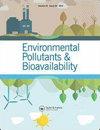Heavy metal and metalloid concentrations in agricultural communities around steel and iron industries in Uganda: implications for future food systems
IF 3.2
4区 环境科学与生态学
Q2 BIOCHEMISTRY & MOLECULAR BIOLOGY
Environmental Pollutants and Bioavailability
Pub Date : 2023-06-19
DOI:10.1080/26395940.2023.2226344
引用次数: 2
Abstract
ABSTRACT Poor management of effluents from steel and iron industries could increase element concentrations in the environment and threaten the health of consumers of food products from these areas. The current study assessed element concentration and physicochemical properties of soils, water, and vegetation from within 200 m around three steel and iron industries. A workable grid-based sampling design guided soil and plant sampling; upstream-downstream water quality comparisons were adapted with upstream as a control sample. Analyses were conducted following procedures by USEPA method 3051A. Element concentration was in the order Mn>As>Zn>Cr>Pb. The concentrations reduced with increase in distance from the industry. There was moderate-to-strong pollution of soils for As, and transfer factor for all elements was >1. In conclusion, industrial activity might have contributed to increased element concentrations in the soils, vegetation, and water sources around the industries. Agrarian activities may only be safely carried out 151m away from the industries.乌干达钢铁工业周围农业社区的重金属和类金属浓度:对未来粮食系统的影响
本文章由计算机程序翻译,如有差异,请以英文原文为准。
求助全文
约1分钟内获得全文
求助全文
来源期刊

Environmental Pollutants and Bioavailability
Chemical Engineering-Chemical Health and Safety
CiteScore
4.30
自引率
3.00%
发文量
47
审稿时长
13 weeks
期刊介绍:
Environmental Pollutants & Bioavailability is a peer-reviewed open access forum for insights on the chemical aspects of pollutants in the environment and biota, and their impacts on the uptake of the substances by living organisms.
Topics include the occurrence, distribution, transport, transformation, transfer, fate, and effects of environmental pollutants, as well as their impact on living organisms. Substances of interests include heavy metals, persistent organic pollutants, and emerging contaminants, such as engineered nanomaterials, as well as pharmaceuticals and personal-care products as pollutants.
 求助内容:
求助内容: 应助结果提醒方式:
应助结果提醒方式:


